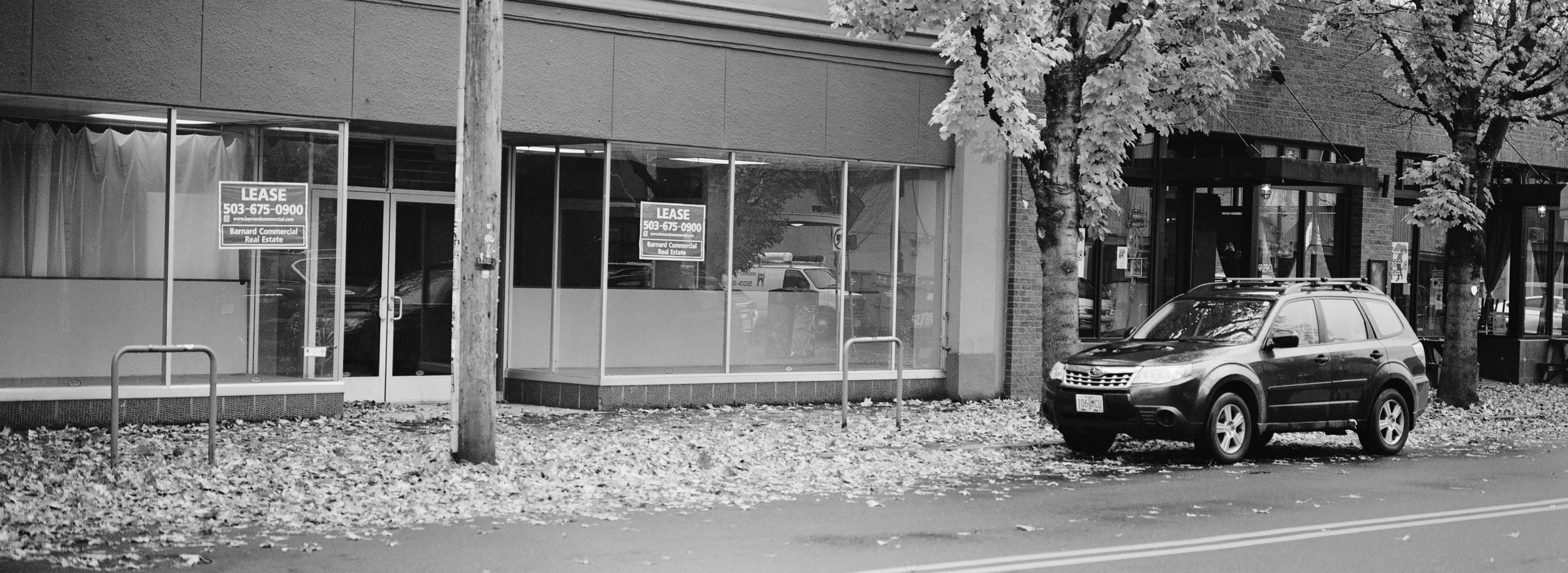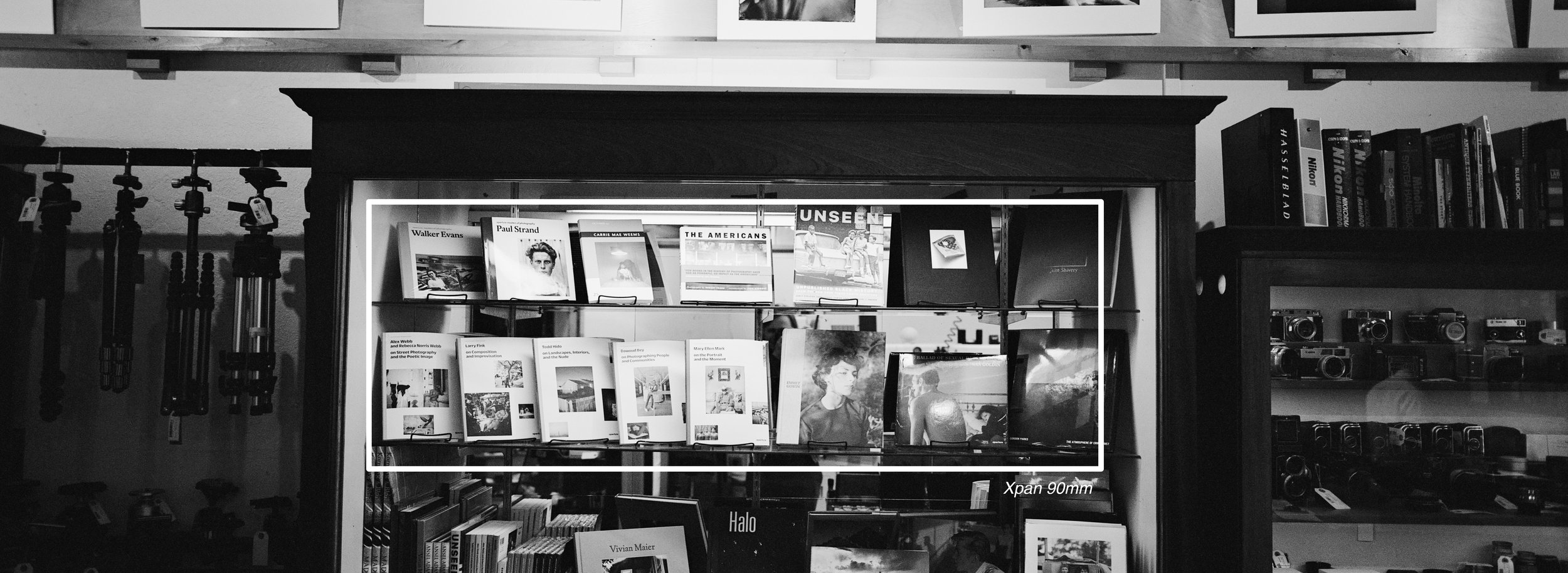Hasselblad XPan 45mm vs 90mm Lens Comparison
Gabriel Binder - Blue Moon Camera - Jan 2022
Hasselblad Xpan / 45mm f4 / Ilford XP2
Each time a Hasselblad XPan passes through our shop, we are reminded of how special this camera is. Built for Hasselblad by Fuji (and also sold as the Fuji TX-1) between 1998 and 2002, only 16,800 XPan cameras were made. For context, Pentax produced over 3 million K1000s — the XPan is an exceedingly rare machine.
Hasselblad Xpan / 45mm f4 / Ilford XP2
The highlight of the XPan system is the 24x65mm panoramic film gate, which is nearly twice as wide as a standard 24x36mm frame. While the camera can cleverly shoot in standard 35mm format (and even intersperse standard and pano frames without wasting film), the XPan was designed to shoot in the panoramic format. The long, thin 1:2.7 aspect ratio gives XPan images a distinctive cinematic look.
Hasselblad Xpan / 90mm f4 / Ilford XP2
Fuji created 3 optics for the XPan system: the 30mm f5.6, 45mm f4, and 90mm f4 lenses. The 45mm f4 is considered the standard lens for the system, yielding a similar vertical angle of view to standard 35mm cameras / lenses but expanding the horizontal angle of view almost twice as wide. The 90mm f4 is a short telephoto and is the XPan lens most often found for sale, as most 45mm lenses are sold with camera bodies as kits. The 30mm f5.6 is a stunning ultra-wide optic but is even harder to find than XPan cameras themselves.
Hasselblad Xpan / 45mm f4 / Ilford XP2
In this test, we compared the XPan 45mm f4 and 90mm f4 lenses directly. How do images made with each lens change the feeling of a scene, and which lens is a better “standard” optic for the XPan system? To test this, we made images with both lenses while standing in the same spot to compare their field of view. Each image was shot wide open at f4 with the Auto shutter speed setting on Ilford XP2.
Hasselblad Xpan / 90mm f4 / Ilford XP2
The XPan 45mm f4 offers an expansive wide angle view that takes advantage of the XPan system’s unique aspect ratio. The street scene below illustrates just how much wider the 45mm lens is than the 90mm. The 45mm easily captures an entire block, its greater vertical angle of view creating an atmospheric quality. The XPan 45mm is an excellent travel lens for this reason — a single image can capture the character of a time and place. The XPan 45mm f4 is remarkably sharp and distortion-free.
The XPan 45mm f4’s compact dimensions also make it an excellent choice for travel, keeping the somewhat large XPan small enough to fit in a shoulder bag. XPan 45mm lenses came new with a neutral density center filter that evens frame illumination (eliminates vignetting) for critical use. This is helpful when shooting slide film or in images with large sky areas, but in practice it is usually possible to leave the filter off and retain the extra stop of light that the filter absorbs. These images were made without using the 45mm center filter.
The XPan 90mm f4 doubles the focal length of the 45mm and in some ways makes even more dramatic use of the XPan’s unique aspect ratio. Featuring pronounced vertical compression similar to many 35mm portrait setups, the 90mm maintains the expansive horizontal angle of view inherent in the 24x65mm format. This combination of compression “zoom” and the panoramic width of the format results in a unique perspective. It’s a similar effect to using a long telephoto lens on a 4x10 view camera — the XPan 90mm renders a tight-cropped yet wide view. This gives the 90mm excellent ability to highlight a subject against the background of a cinematic frame.
Hasselblad Xpan / 45mm f4 / Ilford XP2
Hasselblad Xpan / 90mm f4 / Ilford XP2
By virtue of its longer focal length, the XPan 90mm f4 offers much shallower depth-of-field at the same aperture and subject distance as the 45mm f4. The 90mm f4 can create a defocus area that accentuates the details of the subject with a pleasing plasticity. In contrast, the 45mm f4 has an extensive depth-of-field even wide open at f4, making it much less suited to distinguishing a focus area from the background. In most circumstances the deep depth-of-field of the XPan 45mm f4 is a benefit, contributing to even focus across a landscape or street scene. The XPan 90mm f4 adds the ability to separate the subject with selective focus, further dramatizing the already striking XPan frame.
The XPan 90mm f4 is not a particularly heavy optic but is about twice as long as the 45mm f4, which makes sense given its focal length. This makes the 90mm less easy to keep mounted to the camera as a walk around lens, but is still noticeably more compact than medium format setups. The 90mm uses the same hard-to-find plastic lens hood as the 45mm f4 but does not require the use of a center filter, even wide open.
One ingenious feature of the Hasselblad XPan is the complex viewfinder / rangefinder assembly that magnifies the view through the finder when the 90mm lens is mounted. This means that instead of having a small 90mm frame line floating in the center of the XPan’s standard 45mm viewfinder frame, the XPan enlarges the 90mm frame lines to fill the full viewfinder, greatly enhancing focus ability and composition. This is a feature that Leica (and other rangefinder) users can only dream of!
Ultimately, both the 45mm f4 and 90mm f4 lenses are excellent optics. This comes as no surprise given Fuji’s reputation for creating amazing lenses. However, our experience testing both lenses shows that the 90mm is much more than a limited-use telephoto — it is an essential “second standard” lens for the XPan system that capitalizes on the 24x65mm format with a unique combination of width and compression. If you are shooting an XPan or TX-1 with a 45mm and have the opportunity to pick up the 90mm, it is likely to become an indispensable part of your kit.
At the time of writing, Blue Moon Camera & Machine is pleased to have an XPan 90mm f4 available for sale in our store and on our site. Don’t sleep on this one.
- 1.4.22 gb













